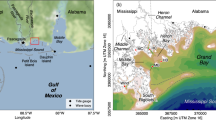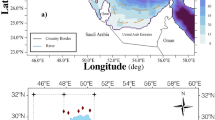Abstract
Observations of a large temperate embayment in Victoria, Australia, reveal a sustained climatic shift that occurred in response to a prolonged drought in the region during 1997–2009. Historically, the bay is fresher than the ocean with fresh outflow to the sea. However, the drought has caused substantially elevated salinity and temperatures above adjacent oceanic waters. The bay's capacity to dilute and flush waste discharges to the ocean was also changed. Observed conditions have been numerically modelled with hydrodynamic and coupled lagrangian particle dispersion models to test differences in dispersion and exchange during historically fresher conditions and hypersaline bay scenarios. Further scenarios were tested for projected climate conditions which were similar to the recent drought responses in the bay. The models identified the effects on the circulation of the climatic shift including regions of increased vulnerability to extreme salinity in the bay, with some existing discharges concentrating in these regions of heightened vulnerability. Absolute salinity in the bay could reach critical levels of over 38 g kg−1, in places, which may compromise bay ecology.















Similar content being viewed by others
References
Argent R, Pexton HM, McAlister AB (2007) The PortsE2 decision support system—an application of E2, In: Oxley L, Kulasiri D (eds) MODSIM07 international congress on modelling and simulation: Christchurch, New Zealand, Modelling and Simulation Society of Australia and New Zealand. pp 895–901. At: http://www.mssanz.org.au/MODSIM07/papers/15_s37/ThePortsE2_s37_Argent_.pdf. Accessed 27 June 2011
Aubrey DG, Friedrichs CT (eds) (1996) Buoyancy effects on coastal and estuarine dynamics, Coast Estuar Stud, 53, 360p AGU, Washington, D.C., doi:10.1029/CE053
Ball D, Soto-Berelov M, Young P, Coots A (2009) Baywide Seagrass Monitoring Program—historical seagrass mapping. Fisheries Victoria Technical Report Series No. 70. At: http://www.oem.vic.gov.au/Assets/809/1/HistoricalSeagrassMapping_10Dec09_Final.pdf. Accessed 27 June 2011
Bathgate R (2010) Connectivity in marine invertebrate populations and the role of marine protected areas. PhD dissertation, University of Melbourne
Black KP, Gay SL (1987) Eddy formation in unsteady flows. J Geophys Res 92(C9):9514–9522
Black KP, Gay SL (1988) A numerical scheme for determining trajectories in particle models. In: Bradbury R (ed) Acanthaster and the coral reef: a theoretical perspective. Lecture notes in Biomathematics, Springer-Verlag, pp 151–156
Black KP, Parry GD (1999) Entrainment, dispersal and settlement of scallop dredge sediment plumes: field measurements and numerical modelling. Can J Fish Aquat Sci 56:2271–2281
Black KP, Moran PJ, Hammond LS (1991) Numerical models show coral reefs can be self-seeding. Mar Ecol Prog Ser 74:1–11
Black KP, Hatton D, Rosenberg M (1993) Locally and externally driven dynamics of a large semi-enclosed embayment in Southern Australia. J Coast Res 9(2):509–538
Black KP, Oldman J, Hume T (2005) Dynamics of a 3-dimensional, baroclinic, headland eddy. NZ J Mar Fresh Res 39:91–120
Booth D, Edgar G, Figueira W, Jenkins G, Kingsford M, Lenanton R, Thresher R (2009) Temperate coastal and demersal fish and climate change. In: Poloczanska ES, Hobday AJ, Richardson AJ (eds) A marine climate change impacts and adaptation report card for Australia 2009. NCCARF Publication 05/09, ISBN 978-1-921609-03-9, pp 1–19
Boyer JN, Kelble CR, Ortner PO, Rudnick DT (2009) Phytoplankton bloom status: chlorophyll a biomass as an indicator of water quality condition in the southern estuaries of Florida, USA. Ecol Ind 9(6):S56–S67
Brown V, Davies R (1991) The environmental water quality of north-western Port Phillip Bay. Melbourne Water environmental Services Technical Report, 91/005
de Silva Samarasinghe JR, Lennon GW (1987) Hypersalinity, flushing and transient salt-wedges in a tidal gulf—an inverse estuary. Estuar Coast Shelf Sci 24(4):483–498
Domingues RB, Anselmo TP, Barbosa AB, Sommer U, Galvão HM (2011) Nutrient limitation of phytoplankton growth in the freshwater tidal zone of a turbid, Mediterranean estuary. Estuar Coast Shelf Sci 91(2):282–297
Ellis PS, Shabani AMH, Gentle BS, McKelvie ID (2011) Field measurement of nitrate in marine and estuarine waters with a flow analysis system utilizing on-line zinc reduction. Talanta 84(1):98–103
Fielder DS, Bardsley WJ, Allan GL, Pankhurst PM (2005) The effects of salinity and temperature on growth and survival of Australian snapper, Pagrus auratus larvae. Aquac 250(1–2):201–214
Gräwe U, Wolff JO, Ribbe J (2010) Impact of climate variability on an East Australian Bay. Estuar Coast Shelf Sci 86:247–257
Harris G, Bately G, Fox D, Hall D, Jernakoff P, Molloy R, Marray A, Newell B, Parslow J, Skyring G, Walker S (1996) Port Phillip Bay environmental study final report. CSIRO, Canberra
Hearn CJ, Largier JL, Smith SV, Plant J, Rooney J (1996) Effects of changing bathymetry on summer buoyancy dynamics of a shallow Mediterranean estuary; Tomales Bay California. In: Aubrey DG and Friedrichs CT (eds) Buoyancy effects on coastal and estuarine dynamics. Coast Estuar Stud 53:243–253
IMOS (2009) Integrated marine observing system, Ships of Opportunity Facility. At: http://imos.org.au/soop.htm. Accessed 27 June 2011
IOC, SCOR, IAPSO (2010) The international thermodynamic equation of seawater—2010: calculation and use of thermodynamic properties. Intergovernmental Oceanographic Commission, Manuals and Guides No. 56, UNESCO. 196 pp
Jenkins GP, Black KP, Keough MJ (1999) The role of passive transport and the influence of vertical migration on the pre-settlement distribution of a temperate, demersal fish: numerical model predictions compared with field sampling. Mar Ecol Prog Ser 184:259–271
Kelble CR, Johns EM, Nuttle WK, Lee TN, Smith RH, Ortner PB (2007) Salinity patterns of Florida Bay. Estuar Coast Shelf Sci 71(1–2):318–334
Largier JL, Hearn CJ, Chadwick DB (1996) Density structures in low flow estuaries. In: Aubrey DG and Friedrichs CT (eds) Buoyancy effects on coastal and estuarine dynamics. Coast Estuar Stud 53: pp 227–241
Last PR, White WT, Gledhill DC, Hobday AJ, Brown R, Edgar GJ, Pecl G (2010) Long-term shifts in abundance and distribution of a temperate fish fauna: a response to climate change and fishing practices. Glob Chang Biol. doi:10.1111/j.1466-8238.2010.00575.x
Longmore A, Nicholson G (2010) Baywide nutrient cycling (denitrification) monitoring program milestone report no. 11 (June–September 2010). Fisheries Victoria Technical Report Series No. 118. At: http://www.oem.vic.gov.au/Assets/957/1/NutrientCyclingMilestoneRep11_22Dec10_Final.pdf. Accessed 27 June 2011
EPA Victoria and Melbourne Water (2009) Better bays and waterways: a water quality improvement plan for Port Phillip Bay and Westernport region. Report to the Australian Government. At: http://www.epa.vic.gov.au/water/coasts/betterbays.asp. Accessed 27 June 2011
Middleton JF, Black KP (1994) The low frequency circulation in and around Bass Strait: a numerical study. Cont Shelf Res 14(13/14):1495–1521
Nahas EL, Pattiaratchi CB, Ivey GN (2005) Process controlling the position of frontal systems in Shark Bay, Western Australia. Estuar Coast Shelf Sci 65:463–474
Najjar RG, Pyke CR, Adams MB, Breitburg D, Hershner C, Kemp M, Howarth R, Mulholland MR, Paolisso M, Secor D, Sellner K, Wardrop D, Wood R (2010) Potential climate-change impacts on the Chesapeake Bay. Estuar Coast Shelf Sci 86(1):1–20
Pawlowicz R (2010) What every oceanographer needs to know about TEOS-10 (The TEOS-10 Primer). At: http://www.teos-10.org/pubs/TEOS-10_Primer.pdf. Accessed June 2011
Pelican Expeditions (2010) Two bays http://www.svpelican.com.au/2bays/science.html. Accessed 31 January 2011
Roessig JM, Woodley CM, Cech JJ, Jr JJ, Hansen LJ (2004) Effects of global climate change on marine and estuarine fishes and fisheries. Rev Fish Biol Fish 14:251–275
Smith SV, Atkinson MJ (1983) Mass balance of carbon and phosphorus in Shark Bay, Western Australia. Limnol Oceanogr 28:625–639
Souza MFL, Kjerfve B, Knoppers B, de Souza WFL, Damasceno RN (2003) Nutrient budgets and trophic state in a hypersaline coastal lagoon: Lagoa de Araruama. Estuar Coast Shelf Sci, Brazil, pp 843–858
Tomczak M, Godfrey JS (1994) Regional oceanography: an introduction. Pergamon, Oxford
Tunnell JW Jr, Judd FW (2002) The Laguna Madre of Texas and Tamaulipas. A&M University Press, Texas
EPA Victoria (2002) Port Phillip Bay water quality. Long-term trends in nutrient status and clarity. 1984–1999. EPA Victoria Publication #806. At: http://epanote2.epa.vic.gov.au/EPA/publications.nsf/PubDocsLU/806?OpenDocument. Accessed 27 June 2011
Whetton P, Power S (2007) Climate change in Australia, technical report. CSIRO and Bureau of Meteorology, ISBN: 9781921232930. At: http://www.csiro.au/resources/Climate-Change-Technical-Report-2007.html. Accessed 27 June 2011
Acknowledgments
This work was borne from an earlier project that was funded by the National Department of Environment and Heritage to develop bay and catchment models for the Port Phillip Bay and Western Port region. The authors wish to thank Shaun Harrison, Sebastien Mancini, Guillaume Martinez, Rachael Bathhgate and Andy Longmore for their contributions to the background of this paper.
Author information
Authors and Affiliations
Corresponding author
Additional information
Responsible Editor: Chari Pattiaratchi
This article is part of the Topical Collection on Physics of Estuaries and Coastal Seas 2010
Rights and permissions
About this article
Cite this article
Lee, R.S., Black, K.P., Bosserel, C. et al. Present and future prolonged drought impacts on a large temperate embayment: Port Phillip Bay, Australia. Ocean Dynamics 62, 907–922 (2012). https://doi.org/10.1007/s10236-012-0538-4
Received:
Accepted:
Published:
Issue Date:
DOI: https://doi.org/10.1007/s10236-012-0538-4




